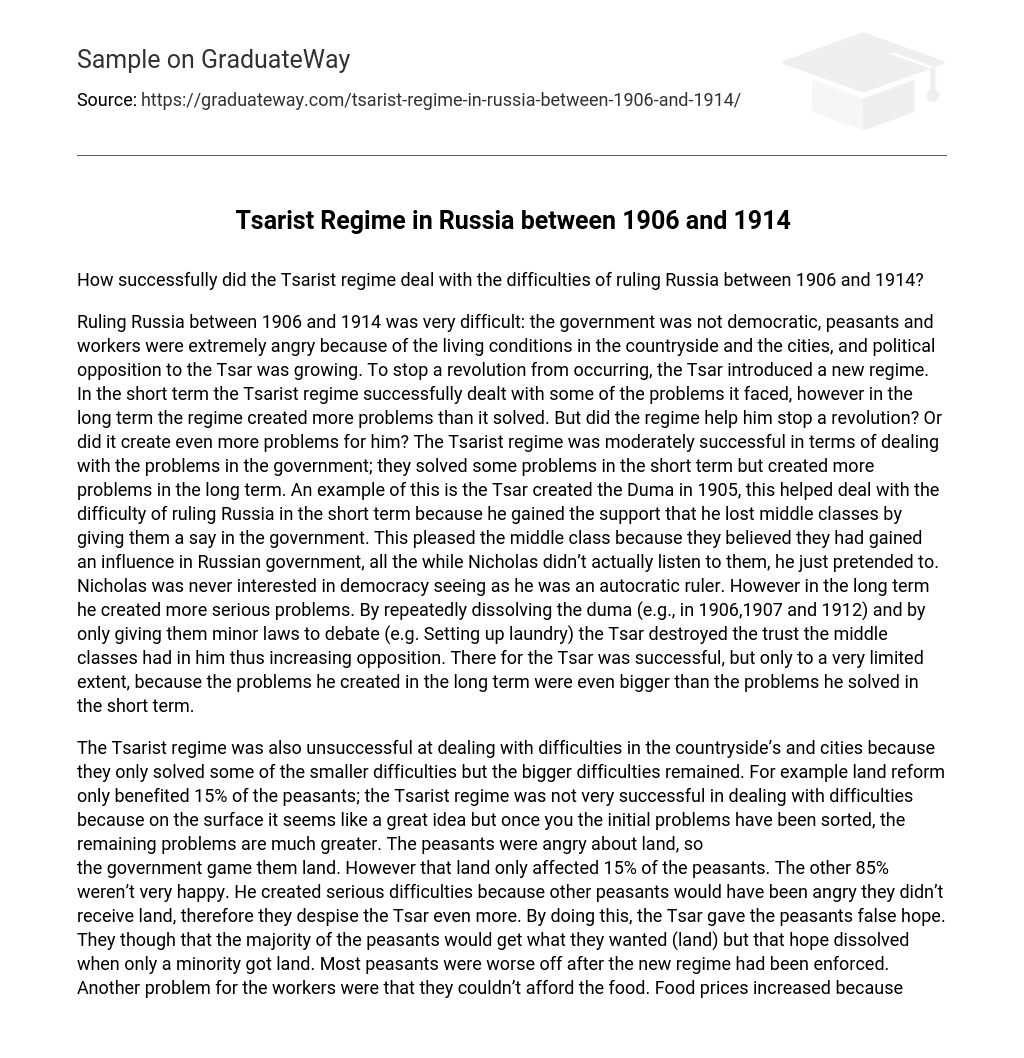How successfully did the Tsarist regime deal with the difficulties of ruling Russia between 1906 and 1914?
Ruling Russia between 1906 and 1914 was very difficult: the government was not democratic, peasants and workers were extremely angry because of the living conditions in the countryside and the cities, and political opposition to the Tsar was growing. To stop a revolution from occurring, the Tsar introduced a new regime. In the short term the Tsarist regime successfully dealt with some of the problems it faced, however in the long term the regime created more problems than it solved. But did the regime help him stop a revolution? Or did it create even more problems for him? The Tsarist regime was moderately successful in terms of dealing with the problems in the government; they solved some problems in the short term but created more problems in the long term. An example of this is the Tsar created the Duma in 1905, this helped deal with the difficulty of ruling Russia in the short term because he gained the support that he lost middle classes by giving them a say in the government. This pleased the middle class because they believed they had gained an influence in Russian government, all the while Nicholas didn’t actually listen to them, he just pretended to. Nicholas was never interested in democracy seeing as he was an autocratic ruler. However in the long term he created more serious problems. By repeatedly dissolving the duma (e.g., in 1906,1907 and 1912) and by only giving them minor laws to debate (e.g. Setting up laundry) the Tsar destroyed the trust the middle classes had in him thus increasing opposition. There for the Tsar was successful, but only to a very limited extent, because the problems he created in the long term were even bigger than the problems he solved in the short term.
The Tsarist regime was also unsuccessful at dealing with difficulties in the countryside’s and cities because they only solved some of the smaller difficulties but the bigger difficulties remained. For example land reform only benefited 15% of the peasants; the Tsarist regime was not very successful in dealing with difficulties because on the surface it seems like a great idea but once you the initial problems have been sorted, the remaining problems are much greater. The peasants were angry about land, so
the government game them land. However that land only affected 15% of the peasants. The other 85% weren’t very happy. He created serious difficulties because other peasants would have been angry they didn’t receive land, therefore they despise the Tsar even more. By doing this, the Tsar gave the peasants false hope. They though that the majority of the peasants would get what they wanted (land) but that hope dissolved when only a minority got land. Most peasants were worse off after the new regime had been enforced. Another problem for the workers were that they couldn’t afford the food. Food prices increased because of industrialization. However the workers couldn’t afford this food and since they lived in the city, they couldn’t grow their own food. Many of the workers ultimately went hungry, creating amnesty towards the Tsar. In terms of control and order the Tsarist regime was successful in dealing with the difficulties of ruling Russia. The tough prime minster, Pytor(Peter) Stolypin, and the use of the military caused the Russians to be frightened, giving into their control. Between 1905 and 1913 the number of strikes in Russia had fallen from 13000 to 3000; the problems of strikes in Russia were solved politically but also socially. The fact that the Russians were forced into the Tsars control by threats shows that this area of the regime was a success and the fallinf figures (from 13000 to 3000) prove this. The secret police (Okhrana) were very active, arresting the public offenders on the streets resulting in fewer strikes. If there were strikes, the military was used to fire on the strikers resulting in a lower number in the long term. Stolypin was an objective man, he made no emotional connections towards the protestors, and had no problems in sending offenders to exile or hanging them in public. The Russians were afraid of showing their anger, as they were afraid of what would happen to them, especially through protests. This shows that the Tsar used his forces to abolish anyone or anything that would have been a threat to him. The Russians could not do anything about it; after all they had no power; that had been taken away from them.
This is one of the significant successes the Tsar had by enforcing the regime. There was no question that it delayed protests, violence, and rebellion; in the long term though, this was the wrong way to deal with the situation. Eventually this made protestors angrier since people were being killed for no reason.
The Tsar was unsuccessful in dealing with the difficulties of ruling Russia between 1906-1914; he made the situation worse by breaking the promises he made and hiring people to scare the Russians into obeying him. The Tsar was inadequate in ruling; instead of finding sensible, long-term solutions, he scared his citizens into obeying him and used scapegoats, such as Rasputin, to be punished for his wrong doings. The regime did heal some problems in the short term, but there were no long-term solutions to the problems his people had. The Tsar didn’t think about the consequences of his actions and so ultimately made the wrong decisions. In fact the regime may have made the Tsars position more threatened. If he hadn’t of introduced and therefore thought of a different solution, the country wouldn’t have felt this sorely towards him. I believe the Tsar was unsuccessful in dealing with the difficulties of Russia between 1906-1914. The regime was only enforced to stop a revolution; it didn’t work.





